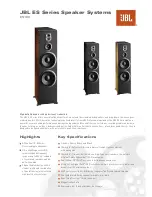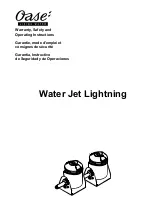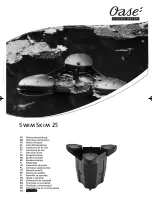
012696 GL0011P-07
– Installation Guidelines for BioDisc BA, BAx, BB & NB Units
Page 7
installation is complete. In such conditions it may be advisable to line the excavation with polythene
sheeting, to prevent cement being washed out of the concrete surround/base.
2.1.4
During installation care must be taken to ensure that the body of any unit is uniformly supported so
that point loads through the unit are avoided.
2.1.5
A water supply must be available on site to enable the unit to be ballasted during back-filling.
2.1.6
Concrete Specification below is a
general
specification. It is not a site specific installation design.
2.1.7
A Dry Site
is defined as one where groundwater lies below the base of the excavation at all times
and the subsoil is free-
draining. If in any doubt, assume “Wet Site” conditions.
GENERAL CONCRETE SPECIFICATION
IN ACCORDANCE WITH BS EN 206-1 ( BS 8500-1)
TYPE OF MIX
(DC) DESIGN
PERMITTED TYPE OF CEMENT
BS 12 (OPC): BS 12 (RHPC): BS 4027 (SRPC)
PERMITTED
TYPE
OF
AGGREGATE
(coarse & fine)
BS 882
NOMINAL MAXIMUM SIZE OF AGGREGATE
20 mm
GRADES: C25 /30
C25 /30
C16 /20
REINFORCED & ABOVE GROUND WITH HOLDING
DOWN BOLTS
REINFORCED (EG. FOR HIGH WATER TABLE)
UNREINFORCED (NORMAL CONDITIONS)
MINIMUM
CEMENT
CONTENT
C30
C20
270 - 280 Kg/M
3
220 - 230 Kg/M
3
SLUMP CLASS
S1 (25mm)
RATE OF SAMPLING
READY MIX CONCRETE SHOULD BE SUPPLIED
COMPLETE
WITH
APPROPRIATE
DELIVERY
TICKET IN ACCORDANCE WITH BS EN 12350-1
NOTE: STANDARD MIXES SHOULD NOT BE USED WHERE SULPHATES
2.1.8
OR OTHER AGGRESSIVE CHEMICALS EXIST IN GROUND WATER
2.2
BioDisc Installation
2.2.1
The package tied to the outside of the unit contains this copy of the Installation Guidelines and a
cover key.
2.2.2
Excavate a hole of sufficient length and width to accommodate the unit and a minimum of 150mm
concrete surround and to a depth which allows for the burial depth of the unit plus a minimum
150mm thick concrete bed.
2.2.3
Lay a concrete bed, of thickness appropriate to site conditions. In wet or unstable ground conditions
it may be necessary to lay an additional hard-core sub-base (see 1.3.4 & 2.1.3).
2.2.4
Lower the unit onto the concrete and bed it in, ensuring that there are no voids under the BioDisc
base.
2.2.5
Unlock and remove the cover. Remove the Control Panel and Owners Pack from inside the unit.
2.2.6
Check that the inlet and outlet orientation is correct and that the unit is level. It is essential that the
unit is installed in a level plane to avoid undue stress on the bearings.
2.2.7
The rotor shaft must be level end to end, to within ±3mm, measured at the bearing caps or directly
on the shaft.
2.2.8
The unit must also be level to within ±5mm from side to side, measured at the GRP walkway on
either side of the rotor.
2.2.9
If necessary, lift the unit off the base and apply further concrete as needed to level up.
2.2.10 Note : The top flange of the BioDisc should not be used for levelling as manufacturing tolerances
may result in it not being parallel with the rotor shaft.
2.2.11 Haunch up concrete all round the base of the unit to at least 150mm above the base level.
2.2.12 Pour water into the primary (inlet) chamber and the final (outlet) chamber, to a depth of 200mm.
2.2.13 Back-fill according to site conditions (see 2.1.7)
2.2.14
Note: 1250mm inlet invert depth units must be back-filled with concrete to within 500mm of
ground level as a minimum, irrespective of site conditions.































